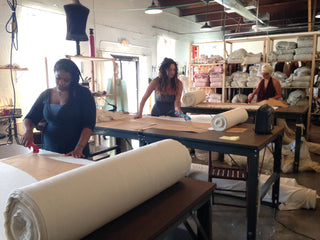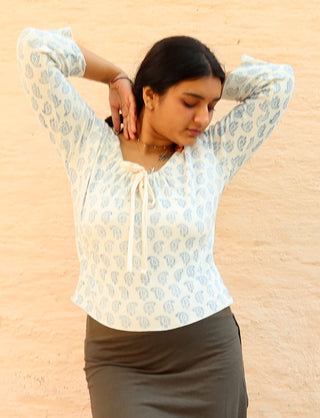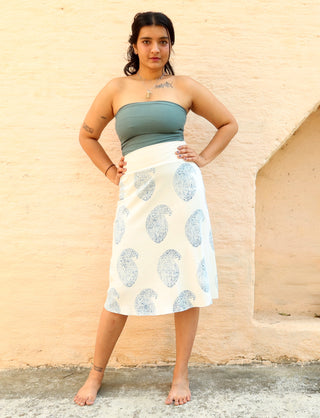Meet Our Founder

2003 - 2005
Hey Y'all, my name is Andrea and in 2003, at the age of 24, I founded Gaia Conceptions with the goal of creating a more environmentally sustainable approach to garment making. I was in college at the time, pursuing a degree in sculpture after switching from a fashion design major a couple of years earlier. The majority of my work centered on developing interactive installations and wearable artworks that raised awareness about environmental contamination.
I had a wide range of interests that all intersected, but I wasn't sure how they all fit together. I was learning everything I could about the environmental challenges my generation faced and possible solutions, as well as teaching myself how to work with natural dyes, expanding my knowledge of permaculture principles, sustainable design, herbal medicine, the Slow Foods Movement, and making clothing to sell at festivals during my summer break.
It was during this time all of my interests coalesced, and I realized I needed to develop something that was both solution- and action-oriented; I wanted my clothing to reflect the lifestyle shifts I was making towards local organic food and sustainable living but it was nearly impossible to find true organic clothing. The small amount of eco clothing available at that time lacked any style or comfort and definitely wasn't made through local organic materials and fair labor production. This underlying motivation, combined with my love of garment making, inspired me to start a clothing brand focused on organic materials, fair labor, and natural dyes.
Gaia Conceptions was born.

Gaia Conceptions remained a minor passion while I pursued my degree in sculpture. In my leisure time, I would sew apparel and sell it at festivals throughout the year. The internet was not what it is today, and festivals were the perfect location to meet people who shared my passion for my work. During this time, I honed my seamstress and dyer skills, learned more about what people wanted from their garments, tried to connect with local organic farmers and mills for our fabrics, and continued my studies into sustainable design across interests.
Although a large portion of Greensboro, North Carolina's textile industry, shifted overseas in the 1990s, there were still a few very seasoned professionals with whom I could contact and discuss my aspirations and dreams for a local fibershed.
It became clear to me that there where others in my community committed to being the change they wanted to see but our goals would take dedication and time. I was figuring out what that meant for me specifically, but I had no idea Gaia Conceptions would evolve into what you see today.

2006 - 2007
Many of these crossing interests led me to India and the Netherlands at the time.
In 2006, I moved to Hyderabad, India, to learn more about the environmental challenges this part of the world faced regarding textile manufacturing. I wanted to find my place within the grassroots initiatives and organizations that were actively working towards challenging the destructive norms around textile production that have devastated the local ecosystems and eroded culturally historical art forms and hyperlocal craft like weaving and dyeing. I became interested in Vandana Shiva's work with seed sovereignty, met like-minded artists working with natural dyes and their medicinal properties, and learned more about the small farms desperately trying to maintain traditional regenerative cotton farming in the face of genetically modified BT cotton.
I spent 8 months traveling throughout India and Nepal, listening and absorbing everything I could. I had barely touched the surface, but a sacred seed had been planted. I made deep lifelong friendships and fell profoundly in love with a country that effortlessly transforms the profane into the holy, instilling within me the ability to recognize the divinity in everything. I knew I'd come back one day.
In 2007, I relocated to Amsterdam, the Netherlands. Moving from India's intensity to Amsterdam's laid-back bike culture was a pleasant shift in environment and pace, lending an indulgent atmosphere where I could begin to digest what I had experienced during my time living in South Asia. The stylish yet functional style of the Dutch will always have an impact on me as a designer, and it was the inspiration for the Skort and Skirted leggings.
I returned to the United States in the summer of 2007 with a revitalized awareness of my dedication to Gaia, a refined love of color, and a head full of simple yet extremely versatile designs that I carried to fall festivals that year.
2008 - 2014
Launching an ETSY shop in the fall of 2007 helped Gaia Conceptions reach a global audience and launch us into the company we are today. I was on my way to Northwestern for my MFA in sculpture when ETSY highlighted me in early 2008. That was it; I suddenly required support to meet demand, and I went from producing 30 garments per week to producing 100 or more. I decided to bring in a team of seamstress and stay in the south to nourish and grow Gaia!
In the beginning we cut everything out on the floor and thought our electric scissors made us so professional. Investing in electric rotary sheers was a big first step in getting garments cut out quicker and cleaner. Let's just say I had a pretty great booty back then thanks to all those lunges.
It was thrilling to acquire professional cutting tables in 2012. Our booties aren't as tight, but our backs are considerably happier. These two photographs are excellent representations of our modest and steady growth over the years.


In 2011, I returned to India to seek out an artisan like myself with whom to collaborate. I had a specific vision in mind that was a little different than modern Indian Blockprinting. First and foremost, the fabric had to be organic, the dyes had to be natural, my print designs had to be unique on a white backdrop, and the fabric had to be knit rather than woven. I knew from my prior trip to India that this would be challenging, especially since, at the time, the dominant textile culture had mostly replaced natural dyes with artificial dyes and the few hand-printers left mostly specialized in printing on woven fabrics with layers of designs with little to no consideration for organic fiber.
But then I found her, Bina Rao with Creative Bee and she was right there in Hyderabad, India the city I had called home 6 years earlier. We talked for days about what I was attempting to do, and it was evident that her passion for preserving traditional natural dye block printing was completely aligned with mine. We went to the farm outside of Hyderabad where she does all of her printing. She assisted me in making contacts to find the organic knit fabric we wanted to print on locally, and she was up for the challenge of attempting something new. My dreams and goals from 2006 where finally a reality.
We talked about our hopes of teaching lessons to other like-minded people, and it felt like a dream come true. It was a defining moment for me in terms of what it meant to participate in global environmental projects. My involvement with her would assist her in funding her goals of preserving an ancient art form while also providing me with wonderful materials to give to the Gaia Community.
It was also encouraging to meet a woman in a male-dominated sector who shared my desire to get our hands dirty and chip away at the changes we wanted to see day by day. We're still talking about creating a workshop for anyone who wants to come to India to learn more about natural dyes, but COVID has put us on hold for the time being.
2014 -2019
In 2014, we relocated to our present studio location. It provided us with twice the space; at 3000 square feet, we had more room to arrange our workflow, a large room for all of our dyeing, and, at the time, a little storefront. We were experiencing substantial growth at the time, which brought with it new questions that required thorough consideration.
We received numerous requests for a wholesale option. We loved the notion of Gaia being sold in boutiques all over the world, but it presented us with unique challenges. We were already offering our clothing at wholesale prices because we were doing everything in-house. To sell wholesale, we would have to restructure and raise our entire pricing structure, reinvent our workflow, and relinquish some control over how our product was presented. In the end, we decided against it since we didn't want to have to raise our rates. That is how we can still sell our product at a wholesale (discounted) price today, making it more accessible to more people.

During this time, we also built a new website, which allowed us to offer complex customization choices and made it easier to organize and navigate through our various options on both the front and back ends. It was incredibly difficult at the time and required the expertise of a web developer to design from scratch. It laid the framework for our newest website, which you are currently viewing.
Gaia Conceptions grew over the next five years as we refined our patterns and fine-tuned our workflow. We visited various locations for photoshoots and largely settled into a consistent and enjoyable routine.
When I had time, I enjoyed developing new designs and delving deeper into the medicinal and energetic properties of our natural dyes through my Offerings.
2020 - 2021
We were going about our business as usual at the start of 2020, until the pandemic struck. We were set to jet to Mexico for our spring photoshoot when the first wave of COVID derailment occurred. I wasn't sure if Gaia Conceptions could continue or what to do next.
One thing I knew for sure was that frontline workers and our Gaia Community needed masks right now, and they were nowhere to be found, but we could make them! So I made a little video showing people how to construct their own masks and made them available on our site. Because of our made-to-order business model, we could produce PPE for frontline employees, and people could get masks right away.
Then they started closing businesses, and I thought, "Well, this is it; we're going to have to close down. But wait, because we made masks, we were deemed an essential service and allowed to remain open while other businesses were forced to close. My earlier pivot to solve a current challenge just saved our butts. It served as a reminder to always make decisions with your heart. Because of our small crew and huge studio space, we were able to do our task while maintaining social distance. Gaia Conceptions would not exist today if these two crucial factors were not present.
As the year progressed and more people began to purchase online, we were inundated with orders. I was able to give my team raises, support other craftsmen, and try out new concepts while still producing important PPE for our community.
Our busiest years thus far have been 2020 and 2021, as a result of the explosive increase in online purchasing during this time. We were in a unique position to give customers exactly what they wanted while allowing them to make purchases from the convenience of their homes.

2022
We began to notice a shift in the Spring of 2022 as inflation picked up, raising the cost of raw materials and production costs while significantly reducing our already slim profit margin. When we learned that other companies much like ours would be closing, we were devastated and realized we would need to come up with a creative strategy to survive.
We simply could not continue to accept returns for custom garments purchased at a wholesale price, but we also did not want to increase our prices, eliminate our coupon code savings, or completely take away our exchange option. We tried lots of different ways to keep offering the Bespoke Garments at the Wholesale prize and finally settled on making these items a Final Sale while offering our Core Collection garments with no customization options exchangeable for store credit.
To put things into perspective a bespoke garment is on average 1 in 30,000 due to all the customization options whereas a Core Collection garment is typically 1 in 40.
2023
We began 2023 by returning to India for our spring and summer photoshoots and to see friends from our undergraduate days in Hyderabad, as well as Bina, who creates all of our natural dye blockprinted fabrics. We also made our first trip to Maheswhar, India, to shoot on location at the lovely Ahilya Fort turned hotel and catch up with our weavers at WomenWeave.
We've always wanted to include handloom fabrics in our fabric selection, but they have to be loomed by hand with botanically dyed organic thread. We were overjoyed to discover the WomenWeave community of artists to assist us in creating our one-of-a-kind materials. Its founding mission was to help local women live better lives by making handloom weaving a profitable, sustainable, meaningful, and dignified source of income.
These beautiful fabrics help us bring elevated texture and pattern to layer in with our our more simple designs. They are light and airy making them perfect for beating the Summer heat or they can easily be layered over and under our other garments in colder months making this a seasonless collection.































